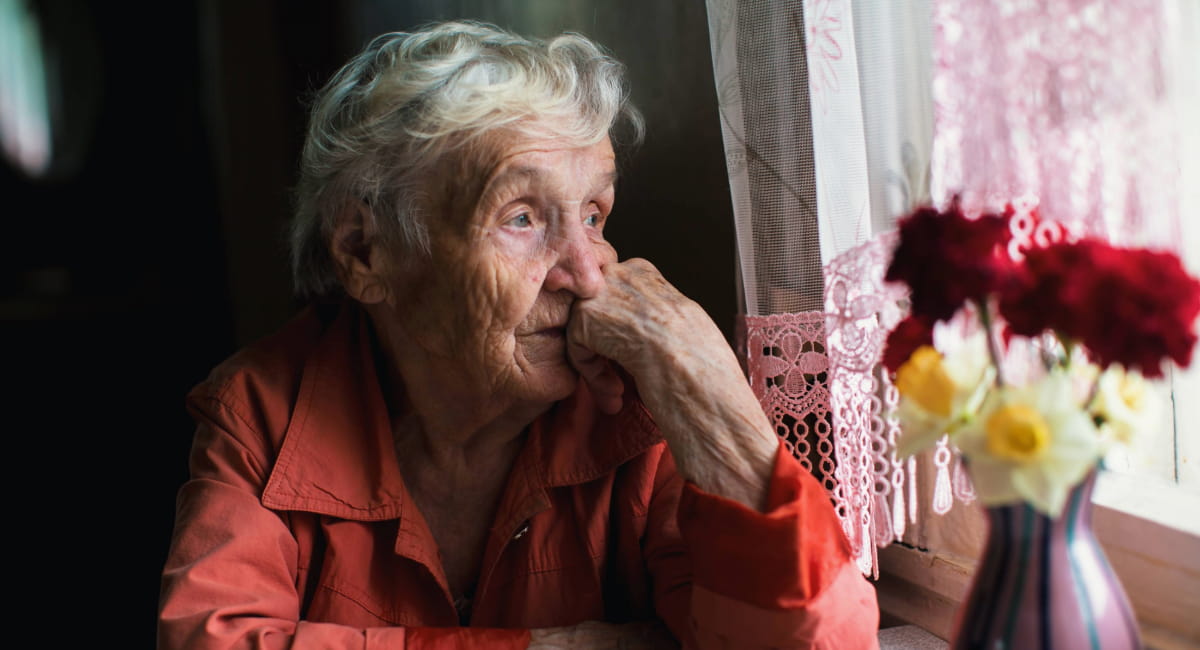“Most people who talk to us don’t want to die. They want to talk through their pain.”—Sam Gross, Counsellor, Australian Unity
Key points
- Suicide can affect anyone—but some people are more vulnerable due to their life circumstances or identity. Learning how to recognise the warning signs can save lives.
- If someone’s struggling, listen without judgement and offer your active support.
- Purpose, connection and access to help can help to protect us in difficult times.
Content warning: This content includes discussion of suicide, death by suicide and mental health.
If you need immediate assistance call Lifeline on 13 11 14.
More than seven million Australians are close to someone who has died by suicide or attempted suicide. And yet, despite its widespread impact, suicide remains one of the most misunderstood and stigmatised mental health issues in our society.
In this article, we speak to the experts from R U OK? and Australian Unity to get beyond the stigma, explore the warning signs of suicide, and learn what each of us can do if we suspect someone is struggling with their mental health and wellbeing.

Who is most at risk of suicide?
Certain groups are more vulnerable to suicide due to a mix of social, psychological and environmental factors.
According to Rachel Clements, Director of Psychological Services at the Centre for Corporate Health Group and a member of the R U OK? Conversation Think Tank since 2014, this includes:
- People with a history of mental health conditions such as depression, bipolar disorder or schizophrenia.
- People experiencing family or relationship violence.
- Older Australians—particularly men aged 75 plus and women aged 45 to 64. Older adults are one group where suicide risk often gets overlooked, Rachel notes, adding that “loneliness, chronic illness or bereavement can hit especially hard in later life.”
- People facing major life changes, such as divorce, financial hardship or isolation.
- Members of the LGBTQ+ community and Aboriginal and Torres Strait Islander peoples.
- Professionals working in high-pressure industries, including law, healthcare and finance.
- Adolescents and teenagers, particularly those dealing with social anxiety or post-COVID adjustment issues.
But anyone can go through a tough time, regardless of whether they belong to one of these groups. As data from the Australian Unity Wellbeing Index, a 24-year study conducted in partnership with Deakin University, shows, Australians’ satisfaction with life has hit the lowest level in the past 20 years.
“Mental health issues don’t discriminate,” says Rachel. “If life pushes someone far enough, anyone can be vulnerable.”
Looking out for suicidal warning signs
Many warning signs of suicidal thoughts overlap with symptoms of depression, but there are some specific cues to look out for.
According to Sam Gross, counsellor with Australian Unity, red flags may include:
- Withdrawal from friends, family or regular activities.
- Mood swings, including sudden calmness after extreme distress.
- Expressing hopelessness, worthlessness or being a burden.
- Neglecting personal hygiene or daily tasks.
- Avoiding future plans or saying things like, “Everyone would be better off without me”.
- Giving away possessions or tying up loose ends.
“Sometimes when someone makes the decision to end their life, they appear unusually at peace,” explains Sam. “It can be a red flag if they’ve been very low and suddenly seem calm.”
Not everyone will show obvious signs, so trust your gut if something feels off. “If something feels off—even if you can’t explain why—lean into that concern and check in,” says Rachel.

Fighting the stigma and creating safe spaces
Despite growing awareness, many people still feel shame or embarrassment around mental health challenges. Teenagers, in particular, can struggle to open up.
“It’s really common for 16-year-olds to come to us saying they’re depressed or suicidal, but they don’t want to talk to their parents or school counsellors,” says Sam. “They feel overwhelmed, ashamed or afraid they won’t be understood.”
Rachel believes storytelling can help shift the culture of silence and isolation.
“When leaders, parents or friends share their own experiences, it normalises the conversation,” she says. “It removes the fear, and helps others feel safe to open up.”
She emphasises the importance of creating “psychologically safe” environments at home, at work, in schools and in communities, where people feel comfortable talking about their mental health. This involves:
- Encouraging honest conversations about mental health and wellbeing.
- Listening with empathy, not judgement.
- Building trust through consistent, supportive behaviour.
- Leading by example, especially for parents, teachers or workplace leaders.
Whether it’s your workplace, the dog park, your footy club or the school pick-up line, psychological safety helps people feel like they’re able to be honest about how they’re really going.
What to say—and do—if you’re worried about someone
Many people worry that asking someone if they’re suicidal will offend them. But Rachel and Sam both agree: if you’re worried someone is struggling, it’s okay to ask directly.
“If someone is already thinking about suicide, that question won’t shock them—it might actually relieve them,” says Rachel. “It tells them they’re seen and that someone cares enough to ask directly.”
Just make sure you ask with gentleness and listen without judgement.
“If someone says they feel hopeless or overwhelmed, ask: ‘Are you having thoughts of suicide?’” says Rachel. “Don’t dance around it—be kind and direct.”
If the person says yes, Rachel’s advice is:
- Stay calm and listen—your presence matters more than perfect words.
- Don’t try to fix the problem or argue them out of it. “You don’t need to have all the answers or try to fix the problem—what matters most is being present and showing you care,” says Rachel.
- Reassure them that they’re not alone, and help connect them with their GP or other professional support.
- If they are in immediate danger, call 000 or take them to the nearest emergency department.
Rachel emphasises the importance of being what she calls an “active connector”.
“Don’t just hand over a phone number,” she says. “Offer to call with them, or to go along to their GP appointment. That kind of support can make all the difference.”
Even if the person isn’t ready to seek help, your support can plant a seed of hope and trust.
“Most people who talk to us don’t want to die,” says Sam. “They want to talk through their pain, but they need someone to listen.”

Strength through connection and support
While recognising risk factors is an essential part of suicide prevention, it’s just as important to understand what helps protect us, especially during life’s most difficult moments.
According to Rachel, protective factors can be surprisingly simple. A strong, trusting relationship, even if it’s just with one person, can provide a vital lifeline.
“It’s not about having a big support network—it’s about having someone you can lean on without fear of judgement,” she says.
In fact, the Australian Unity Wellbeing Index shows that connection and a sense of belonging are among the strongest predictors of personal wellbeing—making even one supportive relationship a powerful protective factor.
A sense of purpose—through family, work, pets or community—can also help people feel more grounded and hopeful. For others, it might be access to mental health support and services, a spiritual or cultural belief system, or simply feeling seen, valued and not alone.
At the end of the day, supporting someone's mental health doesn’t mean having all the answers. It means listening, being real and showing up for each other.
“You don’t need to be a counsellor to help—you just need to care enough to ask,” says Rachel.
Four steps of an R U OK? conversation

There is no right or wrong way to ask someone “are you OK?”. The best thing to do is ask in your own way and continue to check in.
You can follow the four R U OK? conversation steps to let someone know they’re supported and help them find strategies to better manage the load, remember “ALEC” – Ask, Listen, Encourage Action, Check In.
Ask R U OK?
- Pick your moment. Start the conversation at a time and in a place where you’ll both be comfortable.
- If they can’t talk when you approach them, organise a time when they can.
- Be relaxed and friendly in your approach. Think about how you can ease into the conversation.
- If they don’t want to talk, let them know you’ll be there for them when they are ready, or ask if there’s someone else they’d be more comfortable chatting to.
Listen with an open mind
- Be prepared to listen. Don’t try and solve their problems right away.
- Have an open mind.
- Don’t rush them, or interrupt. Let them speak in their own time. Encourage them to explain.
- Show you’ve listened by repeating back what you have heard and asking if you have understood them correctly.
Encourage action
- Once they’ve opened up, encourage them to do something that might lighten the load or, if appropriate, consider professional support.
- You don’t have to have the answers or be able to solve their problems, but you can help them consider the next steps and actions they can take to manage their situation.
- Some good options might include talking to your Employee Assistance Program, a family member, a trusted friend, their doctor or another appropriate health professional.
- You can also suggest they think about what’s worked for them or helped when they’ve felt this way or faced similar challenges in the past.
- Things that help them relax or bring them joy might include going for a walk, seeing a movie, watching or playing some sport.
Check in
- Remember to check in again soon to see how the person is doing. During the conversation, ask them to suggest a time that’s good for them: “Do you mind if we catch up again soon to see how you’re travelling?”
- Ask them how they’re feeling and if they’ve found ways to better manage their situation.
- If they haven’t done anything, be encouraging and remind them you’re always there if they need a chat. Remember that for now they might just need someone to lend a listening ear.
- Understand that it can sometimes take a long time for someone to be ready to see a health professional. Try to reinforce the benefits of seeking professional help and suggest they try different avenues.
- If they’ve had a bad experience with a helpline or doctor, encourage them to keep trying. You could ask, “Would it be useful if we tried some other options to help you get through this?”
- Pop a reminder in your diary to drop in or call them in a couple of weeks. If they’re really struggling, follow up with them sooner.
- Stay in touch and be there for them. Genuine care and concern can make a real difference.
Published with permission from R U OK?


